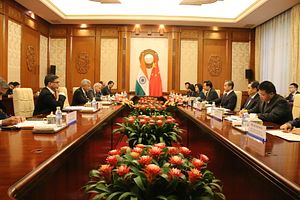For better or worse, the BJP government’s decision to scrap Article 370 of the Indian Constitution is historic in its consequences. While a great deal has been discussed about the move’s internal security and political implications, the bifurcation of the state into two union territories also has significant bearings on India’s strategy vis-à-vis China.
Undivided Jammu and Kashmir (J&K) consists of the erstwhile Indian state of J&K, Pakistan-administered Kashmir, and Aksai Chin, controlled by China. China also controls the Shaksgam Tract, which was ceded by Pakistan to China by the Boundary Agreement of 1963. Aksai Chin has been occupied since the 1962 Sino-Indian War, and is currently a part of the Xinjiang Uyghur Autonomous Region. Its importance lies in allowing National Highway 219 to connect Xinjiang and Tibet, both of which are under the jurisdiction of China’s Western Theater Command (WTC), which is responsible for all operations along the border with India. While the Shaksgam Tract itself does not pose an immediate military threat to Indian military forces in Ladakh, connectivity between the various Chinese group armies in Tibet and Xinjiang is an important aspect of military operations against Ladakh, Himachal Pradesh, and Uttarakhand.
The history of the Sino-Indian border dispute is convoluted, with China rejecting Indian claims as a vestigial echo of colonialism. Attempts to mitigate the issue include five bilateral agreements signed between 1993 and 2013, none of which are binding. Though the Line of Actual Control (LAC) has not seen armed conflict in recent years, the ambiguity of the agreements lends both countries an opportunity to exert pressure as needed or desired. China has done just that during the 2013 Depsang Valley incursion, recent activities in Demchok, and on many other occasions.
China’s statements on the revocation of Article 370 reflect the seriousness with which Beijing views the move. China has criticized India’s “unilateral” actions in Kashmir, and issued a separate second statement about the status of Ladakh. This statement criticizes the unilateral revision of domestic laws by India, which “unacceptably” undermines China’s territorial sovereignty. China’s actions in protecting its perceived territorial integrity are well documented, from the South and East China Seas to Ladakh, Arunachal Pradesh, and Doklam – all sites of disputed territories that China claims.
While Pakistan did not receive the absolute vocal support it expected from China about its own concerns in the region, perceived pressure on Chinese-funded projects in Pakistan-administered Kashmir combined with abject pleas will undoubtedly yield results. The Pakistani foreign minister, during his hurried visit to China, is bound to request assistance from its “all-weather ally” and embellish the threat to Chinese-funded projects in the region, most significantly the China-Pakistan Economic Corridor, connecting China to a port in the Arabian Sea. Ironically, parallels can be drawn between what India has done in Ladakh and Pakistan’s attempts to assuage Chinese concerns about investing in disputed Gilgit-Baltistan.
Some analysts believe bifurcating J&K will allow India greater flexibility in dealing with Pakistan and China separately, along with revitalizing growth and development in Ladakh. While this may be true for social development indicators, it does not have any bearing on military matters in Ladakh. The proposed administrative system will not address the most glaring deficiency in Ladakh (strategically), that of connectivity and infrastructure in the border areas, as these have always been overseen and funded by the union government. The only relevant streamlining to be expected is in land acquisition (which was never a bone of contention), as this will now be the sole province of the appointed lieutenant governor, and by extension the union government. Additionally, Chinese interests in Pakistan-administered Kashmir ensure that India will not be able to engage the two countries separately. Hence, any significant change in Delhi’s military strategy will not come from how its security forces are deployed in the region, but the manner in which they are directed to function from the center.
Whether External Affairs Minister S. Jaishankar’s visit to China helped soothe ruffled feathers is unclear, but continued Pakistani fear-mongering and Chinese perceptions of India’s “unilateral” move will almost certainly result in reprisals by Beijing along the LAC. While the possible Indian pressure on Chinese projects in the region is bound to be overstated by Pakistan, there may also be truth to those worries. By the Balakot airstrikes in February 2019, and now the revocation of Article 370, the Modi government has displayed a willingness to break from long-accepted norms in dealing with complex strategic issues.
Traditionally, only China has taken advantage of the ambiguity of bilateral agreements to apply pressure on India’s security apparatus in Ladakh and other border areas. By displaying the political will to change existing paradigms, could there be more hawkish engagement with China as well? Can India exert pressure on the Shaksgam Tract (north of the Siachen Glacier), at key infrastructure in Aksai Chin (like highway 219), or even Chinese infrastructure in Pakistan-administered Kashmir? Escalatory though such actions might be, they offer a chance for India to break from the mold of reacting defensively to Chinese provocation, and open up different theaters and options to choose from while negotiating and de-escalating. With the current government at the helm, this possibility can be considered a prediction as well as a suggestion. Either way, India’s security and diplomatic establishment has far more to deal with in the coming months than just Pakistan’s response to the abrogation of Article 370.
Samanvya Hooda is a Research Assistant at the Institute of Chinese Studies, New Delhi. His research interests lie in security studies, military history, and India’s foreign policy.

































